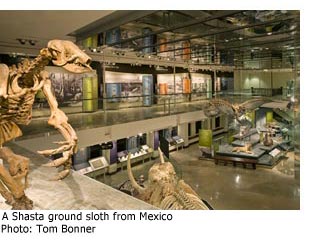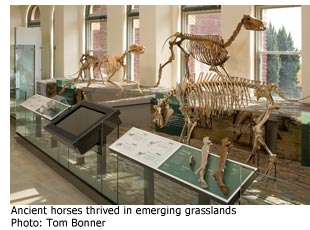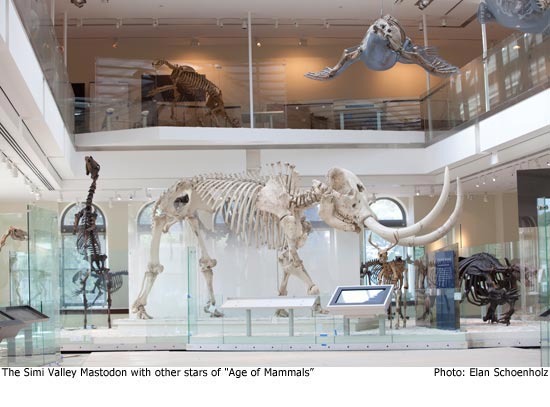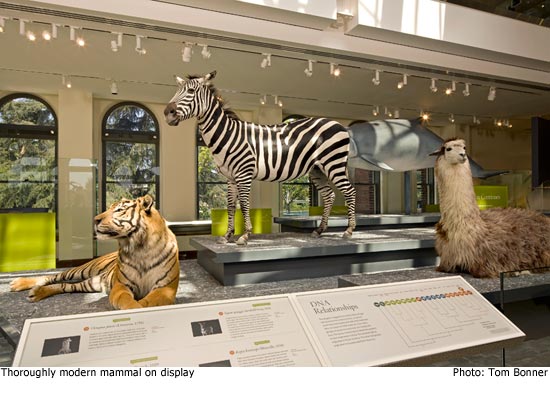Ancient mammals invade museum
July 8, 2010
Say goodbye to boring field trips and uninspired fossils. Say hello to a brand new cast of prehistoric characters that includes a walking whale, a bone-crushing dog and a “thunder beast” that looks like a cross between a dinosaur and a rhino.
They may be extinct but they sure know how to bring an exhibition to life.
They’re among the stars of the groundbreaking “Age of Mammals” exhibition at the Natural History Museum, which opens July 11 to tell a 65-million year story of mammals—from the fall of dinosaurs to the present day.
The animals have an undeniable cool factor, but the explanations and interactive displays are just as interesting, since they connect the animals to the deeper story of mammal evolution as clearly as, well, your thigh bone’s connected to your hip bone.
 “We’re trying to get to the essence of what a natural history museum should be for a 21st century audience,” says museum president and director Jane Pisano.
“We’re trying to get to the essence of what a natural history museum should be for a 21st century audience,” says museum president and director Jane Pisano.
“Age of Mammals” is the first major permanent exhibition to open as part of an ongoing rebuilding and transformation project leading up to its Centennial in 2013 called “NMH Next.” The project started with the completion last year of a state of the art restoration of the museum’s historic 1913 Building that is finally on display with the opening of the new space. (Read more about the renovation and future exhibits here.)
The new mammals exhibit fills the two-story north wing of the restored building, but the show is housed in a fully modern space lit by a giant skylight and broad rows of windows. Video loops and interactive touch screen displays animate the exhibit.
Virtually all mammals are warm-blooded vertebrates, with hair, who feed their young with milk. But as this show makes clear, the similarities can end there. Here are some of the show’s stars:
- The Simi Valley Mastodon, a 50,000 year old skeleton found in 2001 at a construction dig near the Ronald Reagan Freeway. Nearly nine feet high, it’s the biggest fossil skeleton in the show.
- A giant Paleoparadoxiid, with a head like a hippo and bizarre paddle-like feet, “looks like nothing you’ve ever seen before,” says John Harris, the mammal show’s chief curator and director of the county’s Page Museum. No wonder its name means “ancient mystery.”
- The Brontothere, or “thunder beast,” that looks like a dinosaur-rhino mix and sprouts a large Y-shaped horn on its snout.
- A 52 million-year-old “walking whale” from Pakistan that stands (literally, on four legs) as living proof that whales’ ancestors started on land. The family resemblance isn’t obvious. This denizen of lakes and rivers “looks a bit like an overgrown opossum,” Harris admits.
- The 8 million-year old “bone crushing dog” from Kansas that stalked ancient horses as a member of the largest dog family ever discovered.
Beyond the animals, the exhibit is important for telling the sweeping story of mammal evolution. “What’s unique about this exhibit is that we explain why it happened,” Harris says.
 Mammals adapted to global climate changes brought on over millions of years by factors that included the tectonic shift of continents. Or, as a video loop near the mastodon explains: “Continents move, climates change, mammals evolve.”
Mammals adapted to global climate changes brought on over millions of years by factors that included the tectonic shift of continents. Or, as a video loop near the mastodon explains: “Continents move, climates change, mammals evolve.”
An exhibit featuring several ancient horses highlights the rise of swift running grazing animals as warming climates changed forests to grasslands. A display of human evolution shows that grass savannahs were crucial to our development, too.
The displays are full of eye-catching visuals. A pair of cheetahs, a fossil skeleton and a modern stuffed specimen sprint side by side, to show inner and outer views of locomotion. Overhead hang marine fossils including a baby sperm whale, clad in wire mesh to “flesh out” the creatures without obscuring their skeletons.
The exhibition stresses local mammals partly because the collection is rich with them, but also to intrigue visitors who will respond to local sites. as shown in panels on what Los Angeles, Ventura County and the Mojave were like in pre-historic times.
“This is an exhibit for Los Angeles, for Angelenos,” says director of exhibition production Simon Adlam.
Displays on the second floor explain the ideas and techniques that let modern scientists study and understand the ancient world. Near the Paleoparadoxiid, video screens showcase the specimen’s discovery, the excavation and laboratory study.
The exhibit ends with a reminder that humans themselves are now changing the planet’s climate with a threatened polar bear staring from a display case.
“The global warming message is clear, simple and up to date,” says John Long, vice president of research and collections. (A broader climate appeal on the museum’s website can be found here.)
Posted 7/8/2010
















 405 bridge work causes a stink
405 bridge work causes a stink